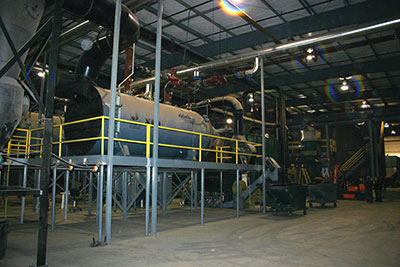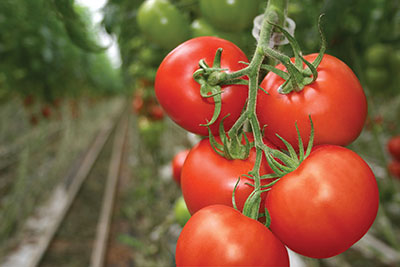
June 27, 2014, Leamington, Ont. — This past winter has been a tough one for Ontario greenhouse operators.
This past winter has been a tough one for Ontario greenhouse operators. The extreme cold that stretched from early December to March meant that natural gas demand across the province was very strong, causing prices to rise.
 |
|
| A view of the biomass unit. PHOTOS COURTESY AMCO Advertisement
|
“We bought over $1 million of natural gas in the last few weeks of February to bring us back to our budgeted consumption forecast,” says AMCO president Fausto Amicone.
“The prices are really volatile right now, and you can’t hedge unknown extra consumption because you don’t know if you’ll need extra volume from increased consumption, so you just keep going.”
Having a biomass plant (three combustion units with a total rated capacity of 85.5 million BTUs and 2400 hp) has come in handy this winter.
Over the winter months, Amicone brought the biomass plant online as extra heat was needed or when natural gas prices were getting too high.
“It costs approximately $8 a gigajoule to run the biomass plant, and natural gas costs escalated much higher than that this past season,” he says. “It’s been about $6.50 per gigajoule on average this winter, and right now (mid-March) it will be high because consumption has been so high.”
VERSATILE BIOMASS SYSTEM CAN BURN A VARIETY OF FEEDSTOCKS
Installed in 2005, the biomass plant provides heat to the greenhouses using a variety of feedstocks, including wood chips, wood pellets and corncobs.
“It was intended to provide heat, CO2 and electricity, but we cancelled the electricity generation part of the project and haven’t yet returned to it because electricity was reasonably priced,” Amicone explains.
“Natural gas has been so low over the last few years that we haven’t run the plant much, until this winter. We are trying to collect CO2 with one scrubber from the flue gas right now, and we’ll see how the trial goes.” The installation of the plant won AMCO an Ontario Premier’s Award for Agri-Food Innovation Excellence.
“Natural gas is getting more expensive, so we’re looking at using the biomass plant more,” Amicone notes. “Yes, it’s costly to bring it online and you need an operator 24 hours a day, but it is looking like we’ll be able to sell a good number of carbon credits relating to it. When it’s on, it’s carbon neutral.”
CARBON CREDIT MARKET HAS BEEN SLOW TO DEVELOP
Back in 2005, when the plant was installed, a stable carbon credit market seemed like a sure thing, but that isn’t the way things turned out.
 |
|
| AMCO has long been an innovation leader.
|
“At this point, however, we have sold some credits, and there seems to be better demand for them now,” Amicone explains. “We are getting more calls than we ever had before, and carbon credits will make a big difference to the feasibility of running the plant.”
Amicone started the business in 1985 with three acres, and it has expanded to a current 80 acres of hydroponic production of tomatoes, cucumbers, eggplants and peppers. AMCO has just over 200 employees.
“What really helped us grow was the switch from pink tomatoes (in demand in Quebec long ago) to red tomatoes, and going into the U.S. market with the red,” he says. “The exchange rate was really good for a long time as well.”
In addition to veggie production, AMCO also packages and delivers its products over large distances.
“It’s important that we do the packing and delivery because it helps us to understand market demand and decide which crops we should plant,” Amicone explains. “It’s a necessary thing to grow the business.”
AMCO delivers in Ontario and Quebec (mainly to Toronto, Montreal, Quebec City) and into the U.S., all the way to New York and Wisconsin, Colorado and Florida.
The company’s traceability strategy continues to evolve and involves bar codes on pallets and boxes.
BIOMASS HEATING JUST ONE OF SEVERAL ENERGY PROJECTS
Developing the carbon credit and CO2 capture aspects of the biomass plant are far from the only energy-related initiatives happening at AMCO.
“We have another project that we are working on that includes cogeneration using reciprocating engines to generate electricity while taking benefit from the heat and CO2 that’s generated,” Amicone explains.
“We are again evaluating the economics now, and we’ll know our position in the next two months in terms of whether we’re going to implement it. The global adjustment of Hydro One has changed the cost structure of electricity tremendously and it keeps changing. The cost of electricity is apparently going to double or triple, so we need to look at our options carefully.”
(Amicone adds that he’d like to supplement the greenhouse lighting to go year-round, but that he can’t secure a good enough price right now to move forward with that.)
There are few of these reciprocating engine systems in use in North America, says Amicone, but many in the Netherlands.
“They had a big crisis there a while back where electricity rates went very high and they used these reciprocating engines to make electricity and shunt excess to the grid,” he explains.
“I visited recently and it’s nice to see these systems working well. You get motivated and inspired and excited again.”
INVOLVED IN LED LIGHTING TRIALS
AMCO is also engaged in an LED lighting trial with Philips. Amicone and his staff are looking at putting them in all the greenhouses as top and intermediate lighting.
He says it appears that they will bring production up about 40 per cent, but he won’t be able to quantify that until near the end of this year.
Amicone notes that these lights are coming down in price each year and he thinks the companies have made a lot of progress in terms of their feasibility.
All the projects, of course, are about maximizing profits and minimizing costs.
“We have a lot of other projects going on,” Amicone says. “It’s a good strategy, because one project might not work today, but might work in the future.”
He cites the biomass plant as a perfect example. “We were looking at it because of rising energy costs and the good possibility of carbon credits, but it went sour, but you keep things on the burner because conditions always change.”
U.S. regions growing at a rapid pace
Greenhouse production capacity in the United States seems poised to grow at a rapid pace.
While there have been lots of troubled projects (due to issues like a scarcity of expertise or expansion at a pace that was too fast) and a corresponding lack of lender confidence, things are turning around.
“There are a lot of smaller facilities getting up and running,” notes Fausto Amicone, president of AMCO in Leamington. “They are asking producers here to expand into the U.S., and we are getting a lot of calls about that. There are a lot of incentives being offered.”
Several Canadian companies have invested in U.S. operations over the past few years.
The expertise of Canadian greenhouse growers is in high demand. Utility costs are lower in the U.S. and Mexico compared to Canada, notes Amicone, and there are obviously more favourable temperatures and light levels as well.
Expect more Canadian greenhouse operations to expand into the U.S. and Mexico in the coming years.
Treena Hein is a freelance writer in Ontario and a regular contributor to Greenhouse Canada.
Print this page